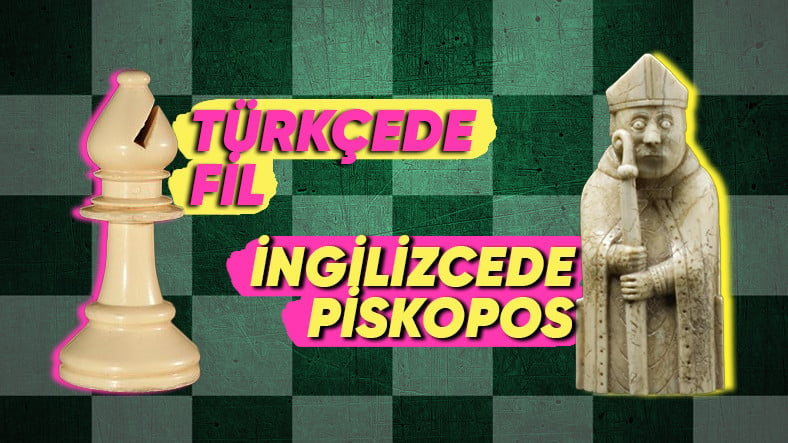A question posed in X has recently led everyone to teach the origins of chess. The question was: Why did the pieces that are “knight/knight” and “queen” in English change to “horse” and “vizier” in Turkish? Moreover, these are not the only differences.
The reason for this question is probably chess. It is a misconception that it came to us from Europe. That’s why it is necessary to get to the real origin of the names of the chess pieces, not their English version.
When the subject became a hot topic, Emrah Safa Gürkan was quick to comment. Let’s see names of chess pieces Where does it really come from?
Differences in the names of chess pieces in Turkish and English
Shah
“king/rajah” in Sanskrit This stone, which carries the meaning, is translated into English in the same way. Its translation into Turkish is “shah”, which means “ruler, especially the ruler of Iran”. Also “check”, as it is known, “checkmate”, “The king is dead.” It means. However, when actually playing with a king, this term was further simplified and “The king has retired.” It was said.
Queen
Although it seems logical at first glance to have a vizier next to the king, some words were passed before we reached this stage. in sanskrit “mantri/king’s advisor” While it is named as “vierge/virgin” in French, “regina/queen” and “dame/lady” in other languages, Arabs “wazir/vizier” They moved on to the word. However, when you look at it, the “queen” piece is still called “queen” in English.
Fil
Elephant is another term that has a faithful Turkish meaning. In Indian chess sets, the piece was also shown as a bishop. Sanskritçede “hasti/in”, Persian words “pil/elephant” passed into our language in the same way. Russians are among those who stick to the word.
In English it is called “elephant” “bishop/overseer” It is said. No one has much of an idea as to why it is said this way. However, in the 12th century, chess pieces carved from walrus ivory “bishop” stonedressed in religious attire for depiction purposes.
At
“asva” means “horse” in Sanskrit The word is one of the unchanging nouns. It was probably thought that it would be possible to jump over other pieces easily with a horse. However, it is not possible to say the same for English.
in english “knight” The reason for this is probably because it tends to reflect this ability universally.
Kale
The word fort comes from Sanskrit, “ratha/chariot”, “rukh” in Persian It was called. German and English also stuck to this word, but in Russian and Armenian, “kale” is called “ship or boat”.
“Doesn’t ‘kale’ mean ‘castle’ in English?” You may be thinking: However, castle here is a game that aims to move the player’s king to a safe position through the use of “castling” and is carried out under certain conditions. move It is used to express. So “rook” refers to a piece and “castle” refers to a type of move.
Pawn
The word pawn is actually a word that has remained consistent throughout the history of chess. Indo-European Latin “pad-foot” The word evolves into Late Latin as “pedōn/yaya”. From here, it is “pion” in French and is used in chess. “infantry” The word is carried to its meaning. It is translated into today’s Turkish and English as a pawn.
There are different terms on this subject. The word “pion” in Old French Derived from “spy” is also considered.
Another assumption is “farmer” in Spanish The word “peon” meaning. It is thought that the word pawn was used because it was sacrificed more frequently during the game. Pawns were a source of cannon fodder to free stronger pieces and get ahead of the enemy.
The history of chess dates back 4 thousand years.
There are many findings about chess played in Mesopotamia, China and Anatolia. To the Kushan Turks The chess pieces belonging to this game indicate that this game was played by them for the first time. The fact that Kushan Turks introduced chess to India and that the first written documents belong to India proves that the history of chess is quite old.
from the Arab-Islamic world through the State of Andalusia Chess spread to Europe via Spain and later became a popular game played in many countries from England to the Netherlands.
You can also check out our other content about chess:
RELATED NEWS
When You Read the Successful Life of Magnus Carlsen, Legend at a Young Age: The Magician of the Chessboard, You Will Applaud His Intelligence
RELATED NEWS
Have you ever wondered whose bright brains created many of the games we all play, such as Chess, Checkers, and Backgammon?
RELATED NEWS
What could be the reason why the vast majority of the world’s best chess players are men?
RELATED NEWS
Who First Thought of Playing ‘Chess’ by Arranging 32 Pieces in 64 Squares? When and How Was Chess Invented?
RELATED NEWS
A Story Full of Records: Who Is Chess’ Most Famous Grandmaster ‘Garry Kasparov’?
RELATED NEWS
What is Chess and How to Play? We Explain It with 20 Basic Moves You Need to Know
Source link: https://www.webtekno.com/satranc-taslari-ingilizce-turkce-ad-neden-farkli-h140762.html


